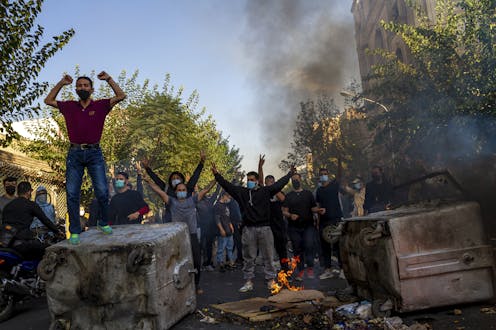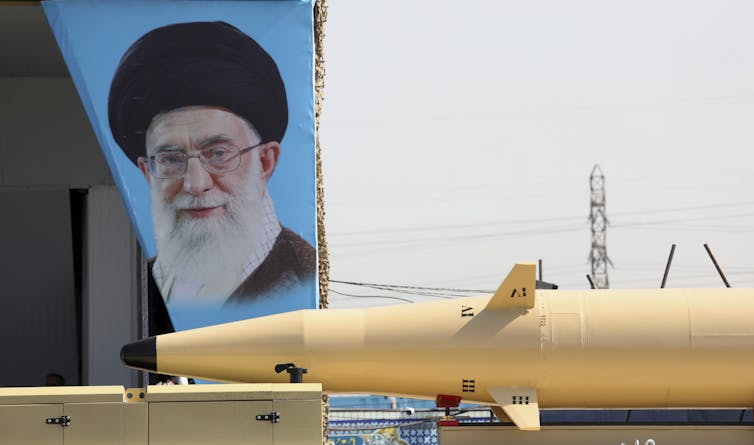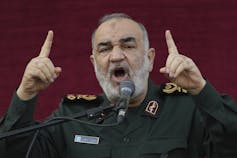
Iran has entered the second month of upheaval with an average of one child murder a day by the Basij, part of Islamic Revolutionary Guard Corps (IRGC), amid the crackdown against the “woman, life, freedom” movement.
The protests began in September 2022 after 22-year-old Mahsa Amini died in the custody of the morality police for allegedly violating the country’s strict Islamic dress code for women.
My own final Handmaid’s Tale-esque experiences with the morality police was as a teenager who got serious warnings in an all-girl school against wearing nail polish or colourful socks outside of neutral school uniform colours.
This is because the Iranian regime considers women second-class citizens who aren’t entitled to the same rights and freedoms as men. It also uses police brutality and re-education centres to discipline girls in an ongoing assault on essential human rights and freedom of expression.
But the broad scope of the protests since September is showing the oppression isn’t limited to women but also the various religious, ethnic and gender minorities who have joined the movement.
Iranian officials are using propaganda and false information in their crackdown on protesters, downplaying the movement’s strength and offering false narratives about the crackdown.
One news organization reports that a dead protester’s family was pressured into saying his death was an accident in exchange for the return of his body.
To further intimidate freedom fighters, the UN says as many as 14,000 people have been arrested since September, including journalists, lawyers, activists and educators. Among them is Toomaj Salehi, a rapper who supported the uprisings by creating protest songs and now faces a death sentence.
Depleting resources as citizens suffer
After every presidential election, the regime has refused to change its draconian laws and ensure fundamental human rights for its citizens or to implement effective environmental policies. Instead, it uses the country’s resources in weapons, nuclear and defence industries to fight foreign wars and deplete energy resources.
Systematic inefficiencies and corruption have led to a water crisis and food shortages, fuelling the public’s anger with the government. There have been sporadic uprisings in Iran for decades, but this time seems different.
Nationwide protests are being organized by grassroots activities without formal leaders because if there were people at the helm, they would be apprehended and imprisoned.
In the meantime, Ayatollah Ali Khamenei blames the United States and Israel for fuelling the protests and accuses them of trying to hinder Iranian progress.

He has said on state television that Iranians benefit from a religious democracy with sufficient freedoms and warned: “No one should dare think they can uproot us.”
The state is drawing clear lines, and uses any attempt to intimidate and curtail the protesters — except for hearing them out.
Strikes, international support
The government’s hard line doesn’t seem to be stopping the protesters and their intent to bring about a revolution. Street protests aren’t limited to Tehran — dozens of other cities are participating.
Petroleum workers, traders and teachers are on strike in many cities, even as the state strengthens enforcement, including soldiers illegally patrolling university campuses.
The protests have powerful international support from Iranians living in the diaspora, evident in massive demonstrations in cities that include Berlin, Toronto and Los Angeles.
Celebrities ranging from Pink Floyd’s Roger Waters and Coldplay to Oprah Winfrey and Shakira, women activists and politicians around the world are speaking out in support of the protesters.
Canada has put pressure and levelled economic sanctions on the regime by banning individuals and entities tied to it, including the IRGC.

While Europe is considering listing the IRGC as a terrorist organization, Iran’s foreign ministry has told German officials that potential sanctions against the IRGC are irresponsible, unconstructive and illegal — ironic considering the IRGC’s commander, Hossein Salami, has warned protesters to stop demonstrating but without offering any concessions.
Risking their lives
Massive internet outages and censorship are in place across Iran. Nonetheless, many Iranians are managing to send videos and photos from hundreds of protests and events that include prison fires, university shootings, massacres of members of ethnic minorities in Zahedan and Sanandaj, women and girls refusing to wear the hijab and general street chaos.
The people sending these images and videos are risking their lives. Diaspora Iranians who are publicly supporting the protests and efforts to overthrow the regime are also at risk of being banned from returning to Iran as punishment.
It’s highly unlikely things are going to go back as they were in Iran, before Amini’s death in September.
Whether the government falls or there’s major reform, exerting both domestic and international pressure, increasing economic sanctions, signing valid and verified petitions and holding local representatives accountable for the situation in Iran is long overdue.
Currently, continuing talks on a nuclear deal with Iran would entail negotiating with a regime that is terrorizing its own people and refusing their demands for freedom.
A democratic Iran that upholds basic human rights isn’t just the dream of protesters. It’s also the only way for the country to address environmental disasters, avoid more wars and to reach a nuclear threat resolution.
But one thing is also certain as the protests show no sign of dissipating: remaining silent about the brutalities of the Iranian regime is to be complacent about unjust killings and arrests.
Noushin Nabavi does not work for, consult, own shares in or receive funding from any company or organization that would benefit from this article, and has disclosed no relevant affiliations beyond their academic appointment.
This article was originally published on The Conversation. Read the original article.







